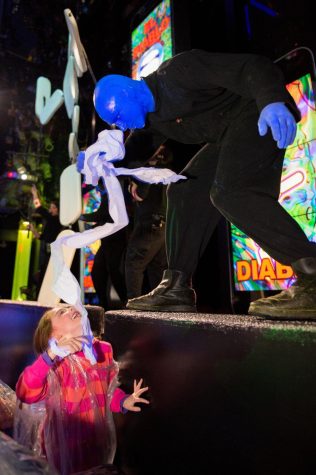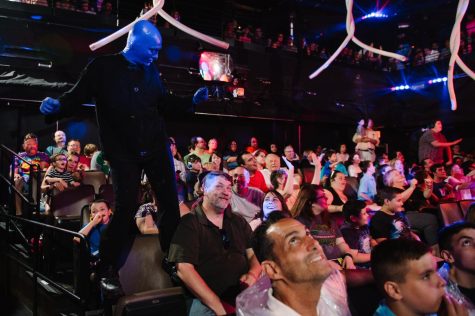Blue Man Group seamlessly encompasses comedic acts and thrilling music to create the perfect viewer experience. From performers banging on drums puddled with wet paint to catching 30 marshmallows in their mouths, this show surpasses average entertainment and pushes audience members into a world of charisma.¬Ý
As soon as the lights dimmed on Nov. 12 at the Charles Playhouse, and the three Blue Men took the stage, the crowd cheered and clapped in contagious excitement. Each Blue Man was visible by a shadow through a screen as they alternated drumming and staring out at the audience. Above them was a hidden band, clad in neon masks and bodysuits, playing catchy instrumentals.¬Ý
Throughout the show, each Blue Man‚Äôs persona shined during their performances. They kept the audience engaged and laughing, and did it all without saying a single word. As soon as that blue paint is on, the Men cease all talking and rely only on facial expressions to crack a joke‚Äîand do so very effectively.¬Ý
‚ÄúThe blue is a neutral mask, and the idea is that you don’t want to over inform that mask from the performer’s perspective because you don‚Äôt want to write the story for them‚Äîyou want to write it just enough that the audience member puts themself in it, then they personalize it,‚Äù said Jason McLin, the longest serving Blue Man in the current Boston cast.¬Ý
McLin began his journey as a Blue Man in 2002 in Chicago, and since then has performed in several markets, including Las Vegas and Toronto.¬Ý
‚Äú[Blue Man] has accompanied me through all these changes in my life,‚Äù said McLin. ‚ÄúIts impact is immeasurable, its influence in my life is everywhere.‚Äù¬Ý
The Blue Man show has an irreversible impact on the lives of its performers, and a whole other effect on the experiences of the younger audience members in attendance.¬Ý
“It was so cool!” said seven-year-old Louis Thatcher with wide eyes and a big smile. “I really liked when he caught all those marshmallows in his mouth.”
William Thatcher, Louis‚Äôs father, said this was their third Blue Man show because it‚Äôs perfect for not only kids, but also adults. Their comedic acts aren‚Äôt limited to a certain age group, he said, which makes the show all the more inviting.¬Ý

“My wife and I love this show,” William said. “We laugh as much as our kids do. Their bits are so entertaining, but I do get nervous that they’ll call me up on the stage one day.”
Interacting with the audience members is a vital aspect of the Blue Man shows, whether it’s throwing marshmallows at the crowd or calling them on stage to paint. Every time a new audience member momentarily joins the three men, the crowd supports them like mothers at a dance competition—by going wild.
Throughout it all, the comfort level between the three men on stage is apparent from a seat in the crowd. Their in-sync performances bring the show together as if you‚Äôre watching real-time siblings in action.¬Ý
‚ÄúThere‚Äôs a lot of emphasis on getting to know the cast, and that‚Äôs an advantageous position to be in because it suggests there would be a lot more depth,‚Äù said McLin.¬Ý
Each Blue Man brings his own cleverness to the stage, causing a little kid to laugh so hard you‚Äôd think the tickle monster was attacking them. McLin said people are fundamentally drawn to this character filled with playful curiosity and mischievousness.¬Ý
Embodying the character, however, requires a mindset trained on how this blue, neutral character can act on stage with the environment that is created. Even though rehearsals precede each show, the performers’ acts combine rehearsed bits with audience reactions and their fellow performers’ reactions to the audience. Each Blue Man’s handle on creativity is tested as every new addition to the crowd brings another path to a nonverbal punchline.
Beyond that, writing the scenes for the characters and anticipating their actions will play out in each unique show comes with its own critical thinking.
“The content comes out of this core character that embodies different archetypes, and we plunk this character into a circumstance—what does it discover out of this world? That’s what drives the content creation,” said McLin. “If we’re experiencing such and such, how will this character respond to that?”
This concept of relating the blue character to modern-day culture trends dates back to when the Blue Man group was formed in 1987, a time in American history that is known for the rise of wealth and capitalism. That context informed the first writings of the Blue Man Group shows.¬Ý
“The first iterations of the show were very much a commentary on the culture of that time—wall street is soaring, and wealth inequality is getting worse and worse,” said McLin. “So [even today], there definitely is commentary about pushing back against the status quo—is this how we want to be living?”

Through verbal silence and music that sends vibrations through audience members‚Äô seats, the Blue Man Group creates passionate performances of all shapes, sizes, and colors. A defining characteristic of the show‚Äôs success comes from crowd reactions‚Äînamely, a crowd filled with people of all demographics.¬Ý
The Charles Playhouse was filled with young kids, older siblings, parents, grandparents‚Äîyou name it. What makes this show unique is how it appeals to people regardless of age, and rather makes a point to let each audience member interpret the performance in their own way.¬Ý¬Ý
“This question of how do you push back in your life is such a wide question that when someone’s in undergraduate—how are they asking themselves that question—and when someone who is in midlife with kids, they are asking themselves that same question,” said McLin. “That’s what’s unique to Blue Man: how they answer it.”
The best part of the show: hearing a seven-year-old laugh so hard it makes you want to laugh along with them. Watching the Blue Men act on whims and let their personalities shine through their antics was as natural as it comes, and that‚Äôs what brought the biggest smiles on audience members‚Äô faces.¬Ý
‚ÄúMy mouth hurts from laughing so much, and this happens everytime I watch this show,‚Äù said Cindy Gatlin, 27, a fifth-time Blue Man audience member. ‚ÄúI love it.‚Äù¬Ý
The lighting effects, fog machines, and red and yellow paint flying across the stage made the show the theatrical performance it was, but the talents and personas of the Blue Men filled the hearts of each viewer‚Äîand that is what makes the show.¬Ý